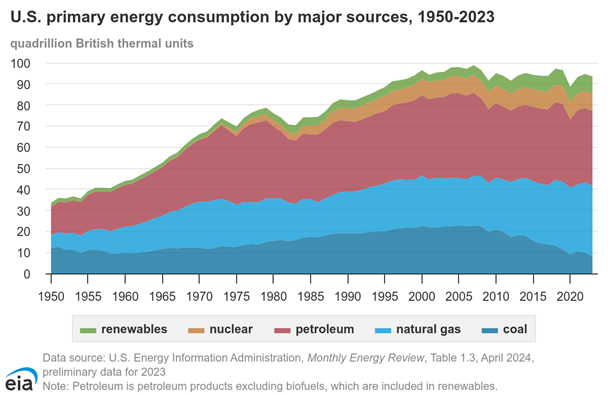During 2017 and 2025, President Donald Trump’s Administrations took several actions to increase coal development and lease sales, primarily through executive orders and changes in federal policy. No matter what federal agencies do, however, economics and the markets drive coal development.
Coal use for electricity generation in the U.S. grew through 1950-2007 but has since declined significantly. In 1950, coal was the largest source of electricity. By 2023, its share of total U.S. energy consumption had dropped to 9%. Coal’s role is diminishing as natural gas becomes the primary fuel for electricity and the use of renewables like wind and solar grows rapidly.
This article reviews the actions the Trump Administration has taken over time and confirms that the use of coal will likely continue to decline.
[1]

Coal Lease Sale Bid Rejected – Less Than a Penny Per Ton
The most recent manifestation of the malaise is that the federal government rejected the recent “low-ball” bid from the sole bidder (i.e., Navajo Transitional Energy Co.) to acquire 167 million tons of coal on federal public lands in Montana. The company bid $186,000 (less than a penny per ton). The failed lease sale would have been the biggest federal government coal sale in over a decade.[2]
The failed Montana coal lease sale vividly demonstrates the lack of interest for coal among utilities generating electricity throughout the country. They are turning to cheaper natural gas and renewables. In spite of the administration’s interest in reviving the coal industry, economists say federal attempts to boost coal are not going to reverse its years-long decline.
Actions During President Trump’s First Term (2017-2021)
In his first term, the Trump Administration tried to reverse the coal policies of the Obama Administration.
- Ended the federal coal leasing moratorium: A 2016 moratorium, which temporarily halted new coal leases on federal lands to allow for an environmental review, was lifted in March 2017. This Trump Administration change reinstated the ability for companies to acquire new leases.
- Rescinded new valuation rules: The U.S. Department of the Interior (DOI) repealed new rules that calculated royalties for coal extracted from federal land based on the sales price, rather than a lower figure. This move effectively reduced the cost for mining companies to extract coal.
Actions During President Trump’s Second Term (2025-present)
President Trump’s second administration has continued and expanded the pro-coal policies of his first term.
- Executive orders: In April 2025, Trump signed a series of executive orders to boost the coal industry. These orders declare that “coal is essential to our national and economic security” and direct federal agencies to take several actions.
- Prioritize coal leasing: Agencies must identify coal resources on federal lands, lift barriers to mining, and prioritize coal leasing.
- Rescind anti-coal policies: Agencies must overturn policies aimed at transitioning the country away from coal.
- Promote “clean” coal technology: Agencies must allocate $625 million toward recommissioning or modernizing aging coal plants.
- Expand federal land for mining: Agencies must open over 20,000 square miles of federal land to mining.
The recent executive orders and proclamations also include directions to various agencies to:
- Promote coal for new technologies such as using coal to power new artificial intelligence (AI) data centers.
- Investigate and challenge state-level laws that restrict the use of coal and other fossil fuels.
- Sharply reduce royalty rates for coal extracted from federal lands.
- Extend – by two years – the date by which coal-fired power plants were to comply with EPA’s National Emissions Standards for Hazardous Air Pollutants.
The same week that the U.S. Department of Energy allocated $625 million in funding for retrofitting and recommissioning aging coal plants to extend their lifespans, the DOI issued a press release stating that it would open 13.1 million acres of federal land to coal mining and streamline approvals for projects in Montana, Wyoming, and Tennessee.
What Ultimately Drives Coal (or any Energy) Development? Economics and the Markets
Federal policies have not been able to reverse the decline in the demand for coal, even when those policies are favorable to the industry. Political attempts to support coal have not, for example, increased employment or production significantly. Some argue that regulations have been a factor, but market forces are the primary driver. Regulations can affect decisions, but market competitiveness remains the larger issue.
Ultimately, market fundamentals are the main drivers of coal development. While federal, state, and local policies can influence the market, they cannot override economic realities that demonstrate that the cost of coal development is rising, and other energy sources are more competitive. Simply put, the cost of coal is increasing, and coal plants have become more expensive to operate. Those realities contrast dramatically with the fact that newer energy alternatives will continue to drive down interest in the use of coal.[3]
This blog was drafted by John L. Watson, an attorney in the Spencer Fane Denver, Colorado, office. For more information, visit www.spencerfane.com.
—
[1] The U.S. Energy Information Administration provides detailed data on energy facts in the U.S. and internationally.
[2] Following the failed Montana auction, the U.S. Department of the Interior also postponed a planned sale of coal reserves in Wyoming.
[3] The reader may wish to track actions by the current administration and Congress re: energy development. One of the best resources for that task is the tracking undertaken by the American Energy Alliance here.[1]
Click here to subscribe to Spencer Fane communications to ensure you receive timely updates like this directly in your inbox.
